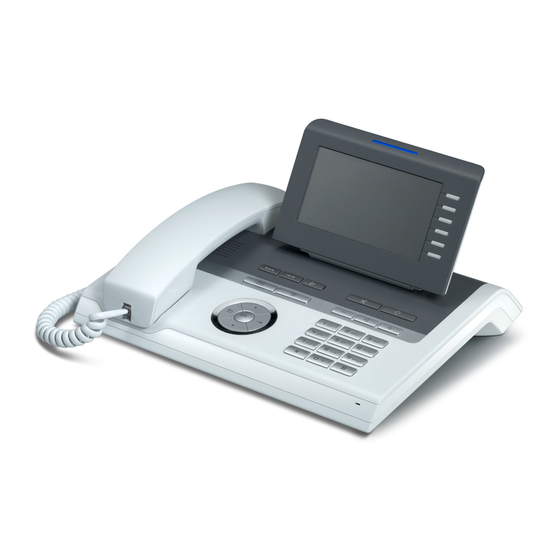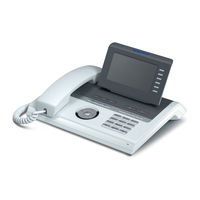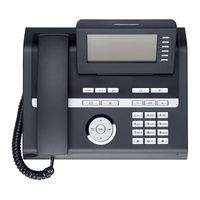
Siemens OpenStage 40 SIP Manuals
Manuals and User Guides for Siemens OpenStage 40 SIP. We have 4 Siemens OpenStage 40 SIP manuals available for free PDF download: User Manual
Siemens OpenStage 40 SIP User Manual (220 pages)
Telephones
Table of Contents
-
-
Key Module17
-
Keys19
-
Display26
-
Phonebooks32
-
Messages34
-
Voice Mail34
-
Calls35
-
-
-
-
In U.S. Mode46
-
Group Call48
-
Call Control51
-
Making Calls53
-
Redial57
-
Callback70
-
-
-
Forwarding79
-
-
Making Calls99
-
Conference104
-
-
Local Phonebook109
-
LDAP Database112
-
Quick Search114
-
Call Lists115
-
Editing Entries115
-
-
-
-
Incoming Calls116
-
Making Calls117
-
During Calls119
-
-
Sample Scenarios126
-
Accepting a Call127
-
-
-
Privacy/Security
136 -
Mobility
144 -
-
Anonymous Calls154
-
Call Tracing155
-
Reachability158
-
Serial Call158
-
Parallel Call159
-
-
Parking a Call161
-
-
Display165
-
Date and Time167
-
Audio171
-
Key Click178
-
Context Menu182
-
Advertisement
Siemens OpenStage 40 SIP User Manual (217 pages)
Siemens Telephone User Manual
Table of Contents
-
-
Key Module17
-
Keys19
-
Display26
-
Phonebooks32
-
Messages34
-
-
-
In U.S. Mode46
-
Group Call48
-
Making Calls51
-
Redial55
-
Callback66
-
-
-
Forwarding75
-
-
Making Calls95
-
Conference100
-
-
Local Phonebook105
-
LDAP Database108
-
Quick Search110
-
Call Lists111
-
Editing Entries111
-
-
-
-
Incoming Calls112
-
Making Calls113
-
During Calls115
-
-
Sample Scenarios122
-
Accepting a Call124
-
-
-
Privacy/Security
133 -
Mobility
140 -
-
Anonymous Calls150
-
Call Tracing151
-
Reachability154
-
Serial Call154
-
Parallel Call155
-
-
Parking a Call157
-
-
Display161
-
Date and Time165
-
Audio169
-
Key Click176
-
Context Menu180
-
Siemens OpenStage 40 SIP User Manual (205 pages)
OpenScape Voice
Table of Contents
-
-
-
In U.S. Mode20
-
Group Call22
-
Call Control26
-
Making Calls28
-
Redial32
-
Callback46
-
-
-
Forwarding55
-
-
Making Calls77
-
Conference82
-
-
Call Lists93
-
-
Making Calls96
-
During Calls98
-
-
Sample Scenarios105
-
Accepting a Call106
-
-
Privacy/Security
115 -
Mobility
123 -
-
Anonymous Calls133
-
Call Tracing134
-
Reachability137
-
Serial Call137
-
Parallel Call138
-
-
Parking a Call140
-
-
One-Way Intercom144
-
Two-Way Intercom144
-
-
-
Display149
-
Date and Time153
-
Audio157
-
Key Click164
-
Context Menu168
-
Advertisement
Siemens OpenStage 40 SIP User Manual (196 pages)
multi-line telephone
Table of Contents
-
-
Key Module17
-
Keys19
-
Display26
-
Phonebooks32
-
Messages34
-
-
-
In U.S. Mode45
-
Group Call47
-
Making Calls49
-
Redial53
-
Callback64
-
-
-
Forwarding73
-
-
Making Calls92
-
Conference97
-
-
Local Phonebook102
-
LDAP Database105
-
Quick Search107
-
Call Lists108
-
Editing Entries108
-
-
-
-
Incoming Calls109
-
Making Calls110
-
During Calls112
-
-
Sample Scenarios119
-
Accepting a Call120
-
-
-
Privacy/Security
129 -
Mobility
136 -
-
Anonymous Calls146
-
Call Tracing147
-
Reachability150
-
Serial Call150
-
Parallel Call151
-
-
Parking a Call153
-
Park a Call153
-
Unparking153
-
Advertisement



